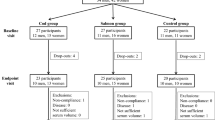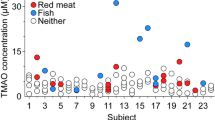Abstract
This work was undertaken to study the impact of the source of n−3 FA on their incorporation in serum, on blood lipid composition, and on cellular activation. A clinical trial comprising 71 volunteers, divided into five groups, was performed. Three groups were given 400 g smoked salmon (n=14), cooked salmon (n=15), or cooked cod (n=13) per week for 8 wk. A fourth group was given 15 mL/d of cod liver oil (CLO) (n=15), and a fifth group served as control (n=14) without supplementation. The serum content of EPA and DHA before and after intervention revealed a higher rise in EPA and DHA in the cooked salmon group (129% rise in EPA and 45% rise in DHA) as compared with CLO (106 and 25%, respectively) despite an intake of EPA and DHA in the CLO group of 3.0 g/d compared with 1.2 g/d in the cooked salmon group. No significant changes were observed in blood lipids, fibrinogen, fibrinolysis, or lipopolysaccharide (LPS)-induced tissue factor (TF) activity, tumor necrosis factor-α (TNFα), interleukin-8 (IL-8), leukotriene B4 (LTB4), and thromboxane B2 (TxB2) in whole blood. EPA and DHA were negatively correlated with LPS-induced TNFα, IL-8, LTB4, TxB2, and TF in whole blood. In conclusion, fish consumption is more effective in increasing serum EPA and DHA than supplementing the diet with fish oil. Since the n−3 FA are predominantly in TAG in fish as well as CLO, it is suggested that the larger uptake from fish than CLO is due to differences in physiochemical structure of the lipids.
Similar content being viewed by others
Abbreviations
- apoA:
-
apolipoprotein A-1
- apoB:
-
apolipoprotein B
- apoE:
-
apolipoprotein E
- CLO:
-
cod liver oil
- CVD:
-
cardiovascular disease
- EIA:
-
enzyme immunoassay
- HRP:
-
horseradish peroxidase
- IL-8:
-
interleukin-8
- LPS:
-
lipopolysaccharide
- LTB4:
-
leukotriene B4
- MPV:
-
mean platelet volume
- RBC:
-
red blood cells
- TF:
-
tissue factor
- TNFα:
-
tumor necrosis factor α
- TxB2:
-
thromboxane B2
References
Dyerberg, J., Bang, H.O., Stoffersen, E., Moncada, S., and Vane, J.R. (1978) Eicosapentaenoic Acid and Prevention of Thrombosis and Atherosclerosis?, Lancet 312, 117–119.
Erkkila, A.T., Lehto, S., Pyorala, K., and Uusitupa, M.I. (2003) n−3 Fatty Acids and 5-y Risks of Death and Cardiovascular Disease Events in Patients with Coronary Artery Disease, Am. J. Clin. Nutr. 78, 65–71.
Hu, F.B., Cho, E., Rexrode, K.M., Albert, C.M., and Manson, J.E. (2003) Fish and Long-Chain Omega-3 Fatty Acid Intake and Risk of Coronary Heart Disease and Total Mortality in Diabetic Women, Circulation 107, 1852–1857.
Lemaitre, R.N., King, I.B., Mozaffarian, D., Kuller, L.H., Tracy, R.P., and Siscovick, D.S. (2003) n−3 Polyunsaturated Fatty Acids, Fatal Ischemic Heart Disease, and Nonfatal Myocardial Infarction in Older Adults: the Cardiovascular Health Study, Am. J. Clin. Nutr. 77, 319–325.
Folsom, A.R., and Demissie, Z. (2004) Fish Intake, Marine Omega-3 Fatty Acids, and Mortality in a Cohort of Postmenopausal Women, Am. J. Epidemiol. 160, 1005–1010.
GISSI-Prevenzione I (1999) Dietary Supplementation with n−3 Polyunsaturated Fatty Acids and Vitamin E After Myocardial Infarction: Results of the GISSI-Prevenzione Trial, Lancet 354, 447–455.
Schmidt, E.B., Arnesen, H., Christensen, J.H., Rasmussen, L.H., Kristensen, S.D., and De Caterina, R. (2005) Marine n−3 Polyunsaturated Fatty Acids and Coronary Heart Disease: Part II. Clinical Trials and Recommendations, Thromb. Res. 115, 257–262.
Schmidt, E.B., Arnesen, H., De Caterina, R., Rasmussen, L.H., and Kristensen, S.D. (2005) Marine n−3 Polyunsaturated Fatty Acids and Coronary Heart Disease. Part I. Background, Epidemiology, Animal Data, Effects on Risk Factors and Safety, Thromb. Res. 115, 163–170.
Hooper, L., Thompson, R.L., Harrison, R.A., Summerbell, C.D., Ness, A.R., Moore, H., Worthington, H.V., Durrington, P.N., Higgins, J.P.T., Capps, N.E., et al. (2006) Risks and Benefits of Omega 3 Fats for Mortality, Cardiovascular Disease, and Cancer: Systematic Review, Brit. Med. J. 332, 752–755.
Bucher, H.C., Hengstler, P., Schindler, C., and Meier, G. (2002) n−3 Polyunsaturated Fatty Acids in Coronary Heart Disease: A Meta-analysis of Randomized Controlled Trials, Am. J. Med. 112, 298–304.
He, K., Rimm, E.B., Merchant, A., Rosner, B.A., Stampfer, M.J., Willett, W.C., and Ascherio, A. (2002) Fish Consumption and Risk of Stroke in Men, J. Am. Med. Assoc. 288, 3130–3136.
He, K., Song, Y., Daviglus, M.L., Liu, K., Van Horn, L., Dyer, A.R., and Greenland, P. (2004) Accumulated Evidence on Fish Consumption and Coronary Heart Disease Mortality: A Meta-analysis of Cohort Studies, Circulation. 109, 2705–2711.
Visioli, F., Rise, P., Barassi, M.C., Marangoni, F., and Galli, C. (2003) Dietary Intake of Fish vs. Formulations Leads to Higher Plasma Concentrations of n−3 Fatty Acids, Lipids 38, 415–418.
Lund, T., and Østerud, B. (2003) The Promoting Effect of Epinephrine on Lipopolysaccharide-Induced Interleukin-8 Production in Whole Blood May Be Mediated by Thromboxane A2, J. Thromb. Haemost. 1, 1042–1047.
Østerud, B., Elvevoll, E., Barstad, H., Brox, J., Halvorsen, H., Lia, K., Olsen, R.L., Sissener, C., Rekdal, O., and Vognild, E. (1995) Effect of Marine Oils Supplementation on Coagulation and Cellular Activation in Whole Blood, Lipids 30, 1111–1118.
Gunstone, F. (ed.) (1989) Official Methods and Recommended Practices of the American Oil Chemists' Society, 3rd edn., American Oil Chemists' Society, Champaign, IL.
Ulberth, F., and M. Henninger (1992) One-Step Extraction/Methylation Method for Determining the Fatty Acid Composition of Processed Foods, J. Am. Oil Chem. Soc. 69, 174–177.
Bligh, E.G., and Dyer, W.J. (1959) A Rapid Method of Total Lipid Extraction and Purification, Can. J. Biochem. Phys. 37, 911–927.
Engstad, C.S., Gutteberg, T.J., and Østerud, B. (1997) Modulation of Blood Cell Activation by Four Commonly Used Anticoagulants, Thromb. Haemost. 77, 690–696.
Galli, C., and Marangoni, F. (2006) n−3 Fatty Acids in the Mediterranean Diet, Prostaglandins Leukot. Essent. Fatty Acids 75, 129–33.
Aursand, M., Bleivik, B., Rainuzzu, J.R., Jorgensen, L., and Mohr, V. (1994) Lipid Distribution and Composition of Commercially Farmed Atlantic Salmon (Salmo salar). J. Sci. Food Agric. 64, 239–248.
Aursand, M., Jorgensen, L., and Grasdalen, H. (1995) Positional Distribution of n−3 Fatty Acids in Marine Lipid Triacylglycerols by High Resolution 13C Nuclear Magnetic Resonance Spectroscopy, J. Am. Oil Chem. Soc. 72, 293–297.
Christensen, M.S., Høy, C.E., Becker, C.C., and Redgrave, T.G. (1995) Intestinal Absorption and Lymphatic Transport of Eicosapentaenoic (EPA), Docosahexaenoic (DHA), and Decanoic Acids—Dependence on Intramolecular Triacylglycerol Structure, Am. J. Clin. Nutr. 61, 56–61.
Arterburn, L.M., Hall, E.B., and Oken, H. (2006) Distribution, Interconversion and Dose Response of n−3 Fatty Acids in Humans, Am. J. Clin. Nutr. 83 (Suppl.), 1467S-1476S.
Finley, J.W., Deming, D.M., and Smith, R.E. (2006) Food Processing: Nutrition, Safety and Quality, in Modern Nutrition in Health and Disease (Shils, M.E., Shike, M., Ross, A.C., Caballero, B., and Cousins, R.J., eds.), pp.1777–1788, Lippincott Williams & Wilkins, Philadelphia.
Østerud, B., Elvevoll, E.O., Barstad, H., Brox, J., Halvorsen, H., Lia, K., Olsen, J.O., Olsen, R.L., Sissener, C., Rekdal, Ø., and Vognild, E. (1995) Effect of Marine Oils Supplementation on Coagulation and Cellular Activation in Whole Blood, Lipids 30, 1111–1118.
Larsen, R., Stormo, S.K., Dragnes, B.T., and Elveroll, E.O., Losses of Taurine, Creatine, Glycine and Alanine from Cod (Gadus morhua L.) Fillet During Processing, J. Food Comp. Anal., in press.
Author information
Authors and Affiliations
Corresponding author
About this article
Cite this article
Elvevoll, E.O., Barstad, H., Breimo, E.S. et al. Enhanced incorporation of n−3 fatty acids from fish compared with fish oils. Lipids 41, 1109–1114 (2006). https://doi.org/10.1007/s11745-006-5060-3
Received:
Accepted:
Issue Date:
DOI: https://doi.org/10.1007/s11745-006-5060-3




